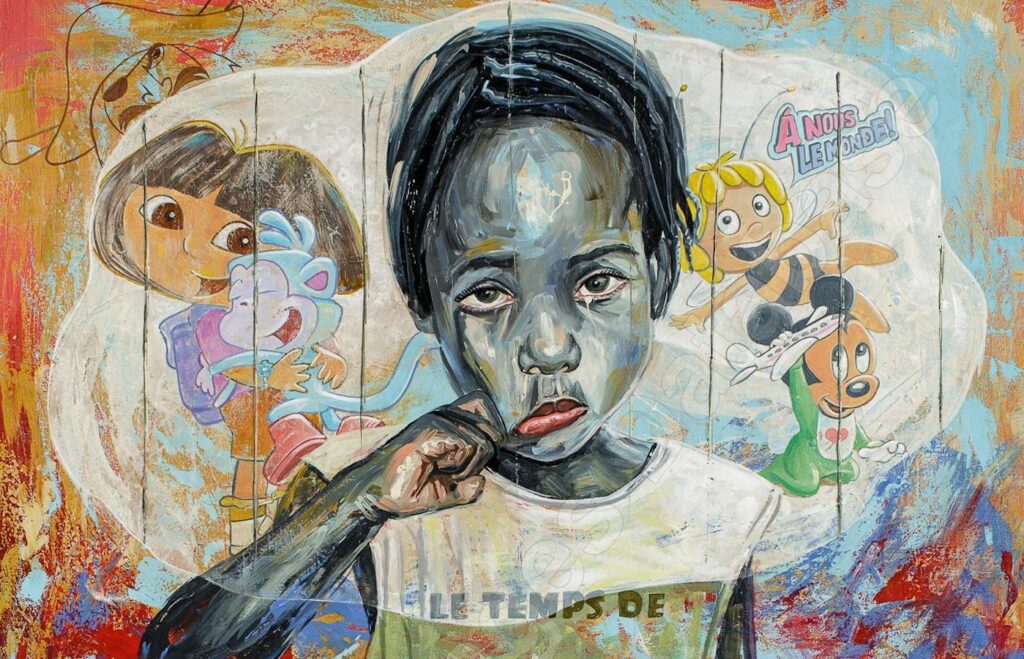Black Liquid Art Gallery, Viterbo, Italy
24 Feb 2024 - 15 Apr 2024

William Tagne Njepe, Enfance Volée, 2024. Courtesy of Black Liquid Art
Superman flying over New York skyscrapers, Doraemon immersed in a sea of stylised daisies by Murakami, a pondering child in tears imagining Dora the explorer, an African Snow White posing for a portrait – no, it’s not a comic book roundup, but these are some of the paintings on display at the exhibition Bam! Zap! Pow! Visual Dialogues between West and Africa in Comic-inspired Art. Artists: Demba Camara, John Madu, Roy Lichtenstein, Mr. Brainwash, Takashi Murakami, Mimmo Rotella, Michael Soi, Tukayo Bailey, William Tagne Njepe
What links contemporary African art to American Pop Art? And what is the relationship between art and comics? These are precisely the questions that the exhibition Bam! Zap! Pow! wishes to answer, exploring the creations of artists who are undisputed protagonists of contemporary art, such as Roy Lichtenstein, Mimmo Rotella, Takashi Murakami and Mr Brainwash. Alongside the well-known names on the international art scene, the Black Liquid Art Gallery, always attentive to the languages coming from the African continent, wished to include the works of African artists such as John Madu, Michael Soi, Tukayo Bailey, William Tagne Njepe, Demba Camara in whom the influence of comics is manifested in a primordial way, mixing the rich artistic tradition of the continent with the immediate and accessible language of cartoons.
In contemporary African art, this fusion has allowed artists to explore new modes of expression, helping to shape the global art scene in a significant way. This reading paves the way for an elevated interpretation of popular culture and mass media, challenging traditional art conventions.
Today, the relationship between comics and contemporary art is a journey of mutual inspiration. In order to fully understand how this connection has enriched both fields, it is necessary to analyse the evolution of the perception of comics over time and how this change has laid the foundations for a change in artistic canons towards an aesthetic closer to cartoons.
According to the American intellectual Gilbert Seldes, American culture must emancipate itself from the sense of inferiority of the so-called genteel tradition, i.e. the European artistic tradition. He emphasises that America possesses a vibrant and dynamic cultural heritage, creatively derived from popular culture. He transfers this analysis to contemporary African culture, where the influence of comics, which came late and only after decolonisation, immediately influenced the stylistic choices and the authentic and identity-based expression of their arts. Contemporary African art represents a case of successful cultural appropriation.
In an interconnected world, where West and Africa are engaged in an ongoing dialogue, cultural interaction has shaped a globalised aesthetic. African artists have skilfully learnt to navigate between tradition and modernity, proposing an expressive language that assumes a role of intellectual relevance.
In the vast production of comics from Africa and considering the rapid evolution that has taken place over the last twenty years, we have chosen to present an exemplification of African comics in the exhibition. Since we cannot be exhaustive, we have focused our attention on a group of creatives from Cameroon, namely the Zebra Comics group. We have selected webtoons narrating characters inspired by African history, culture and mythology.
The exhibition will also feature a selection of animated videos by the Kenyan group Fatboy Animation, which uses animation to advertise commercial products. The characters are a caricature of the Kenyan stereotype that, with humour, create paradoxical and funny situations.